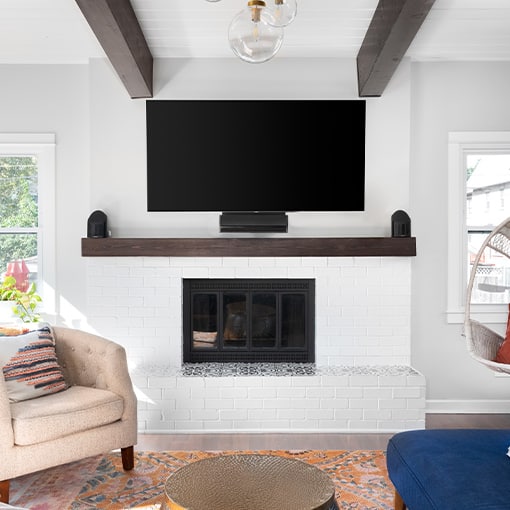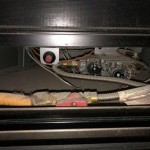The Nuances of Integrating a TV Unit Above a Fireplace
The placement of a television above a fireplace has become a common design choice in modern homes. It offers a convenient solution for maximizing space and creating a focal point within a living area. However, integrating a TV unit above a fireplace requires careful planning and consideration of several factors to ensure both functionality and aesthetic appeal. This article will explore the key elements to consider when designing and installing a TV unit above a fireplace, addressing practical concerns such as heat management, viewing angles, and cable management.
Addressing Heat Concerns and Ventilation
One of the primary challenges in placing a television above a fireplace is managing the heat generated by the fireplace. Excessive heat exposure can significantly reduce the lifespan of electronic components within the television. Prolonged exposure can lead to screen damage, internal component failure, and overall reduced performance. Therefore, proactive measures must be taken to mitigate the potential risks associated with heat.
The type of fireplace is a crucial factor to consider. Gas fireplaces tend to produce less radiant heat compared to traditional wood-burning fireplaces. The heat generated by a wood-burning fireplace can be substantial and necessitate more robust heat mitigation strategies. Electric fireplaces, while often visually appealing, also produce heat and require consideration.
Several strategies can be employed to minimize heat exposure. Installing a mantel serves as a physical barrier, deflecting rising heat away from the television. The depth of the mantel should be proportionate to the size of the fireplace opening and the distance between the fireplace and the television. A wider and deeper mantel provides greater protection. The material of the mantel also plays a role. Non-combustible materials like stone or concrete offer better heat resistance than wood.
Adequate ventilation is equally critical. Creating space between the television and the wall behind it allows for airflow. This ventilation dissipates heat and prevents it from accumulating around the television. Using wall mounts that provide ample clearance is crucial. Furthermore, consider incorporating ventilation features into the TV unit itself. This can include strategically placed vents or fans to promote airflow. In some cases, a dedicated ventilation system with ductwork may be necessary, particularly with high-heat fireplaces.
Regular monitoring of the television's temperature is recommended, especially during extended fireplace use. Temperature sensors can be installed near the television to provide real-time temperature readings. If the temperature exceeds safe operating limits, adjusting the fireplace usage or implementing additional heat mitigation measures becomes essential.
Optimizing Viewing Angles and Ergonomics
Beyond heat management, ensuring a comfortable viewing experience is paramount. Placing a television above a fireplace often necessitates looking upwards, which can lead to neck strain and discomfort over prolonged periods. Therefore, optimizing the viewing angle is crucial for ergonomic design. Several strategies can be implemented to address this concern.
The height of the fireplace significantly influences the optimal television placement. If the fireplace is positioned relatively low to the ground, the television can be mounted lower as well. However, if the fireplace is high, the television will inevitably be placed higher, necessitating further adjustments.
The size of the television also plays a role. Larger screens generally require a greater viewing distance. If the viewing distance is limited, a smaller screen may be more appropriate to avoid visual discomfort. Conversely, if the viewing distance is substantial, a larger screen may be necessary to ensure visibility.
Tilting wall mounts offer a practical solution for improving viewing angles. These mounts allow the television to be angled downwards, reducing the strain on the neck. The degree of tilt can be adjusted to suit individual preferences and viewing positions. Motorized tilting mounts offer even greater flexibility, allowing for remote adjustment of the viewing angle. This is particularly useful in households with multiple viewers who have different preferences.
Before finalizing the installation, it is advisable to simulate the viewing experience by temporarily positioning the television at the intended height. This allows for assessment of the viewing angle and identification of any potential discomfort. Adjustments can then be made before the permanent installation.
Consider the seating arrangement in relation to the fireplace and television. Optimize the furniture placement to ensure that viewers are positioned at a comfortable distance and angle from the screen. This may involve rearranging existing furniture or selecting new furniture that is better suited to the configuration.
Effective Cable Management and Aesthetics
Maintaining a clean and organized appearance is essential for any successful TV unit installation. Exposed cables can detract from the aesthetic appeal of the space and create a cluttered look. Therefore, implementing effective cable management strategies is crucial.
Concealing cables within the wall is the most effective way to achieve a clean look. This involves running the cables behind the drywall, using in-wall cable management kits. However, this typically requires professional installation and may involve cutting into the wall. Electrical codes must be adhered to during this process to ensure safety.
Surface-mounted cable concealers provide an alternative to in-wall wiring. These concealers are typically made of plastic or metal and can be painted to match the wall color. They offer a less invasive solution for concealing cables and can be easily installed by homeowners.
Cable ties, Velcro straps, and cable sleeves are useful for bundling and organizing cables behind the television and within the TV unit. These accessories help to prevent tangling and create a more organized appearance. Color-coding cables can also facilitate easier identification and troubleshooting.
Consider the placement of electrical outlets and cable connections. Ideally, these connections should be located behind the television to minimize visible cabling. If existing outlets are not conveniently located, it may be necessary to install new outlets or relocate existing ones.
Integrating the TV unit design with the overall aesthetic of the room is crucial. The style of the TV unit should complement the existing furniture and décor. Consider factors such as color, material, and design details. A custom-built TV unit can be tailored to perfectly match the specific requirements of the space and the homeowner's preferences. Custom units can incorporate features such as shelving, storage cabinets, and integrated lighting.
Careful planning and attention to detail are essential for successfully integrating a TV unit above a fireplace. By addressing heat concerns, optimizing viewing angles, and implementing effective cable management strategies, a functional and aesthetically pleasing design can be achieved. Consulting with professionals such as electricians, contractors, and interior designers can provide valuable assistance in planning and executing the installation.

Storage Above Fireplace Arredamento Soggiorno Grande Idee Camino Sala Da Prao E Salotto

Can I Mount My Tv Above The Fireplace

Flat Screen Tv Over Fireplace Home Decor Ideas

Recessed Tv Cabinet Home Fireplace Over

Can I Mount My Tv Above The Fireplace

Tv Above Fireplace Design Ideas

Pin By Northwest Metalcraft On Traditional Fireplaces Fireplace Surrounds Tv Above White Surround

ᑕ❶ᑐ What To Consider Before Mounting A Tv Above Fireplace

Mama Needs A New Tv Entertainment Center Designed

Barn Door Tv Cabinet Above Mantle Cleverly Inspired Over Fireplace Cabinets
Related Posts








